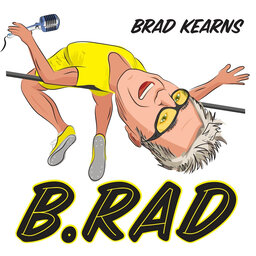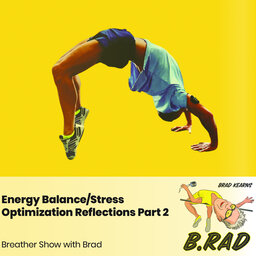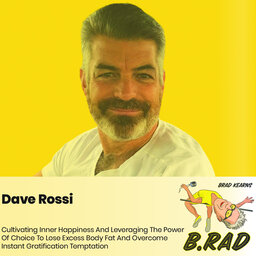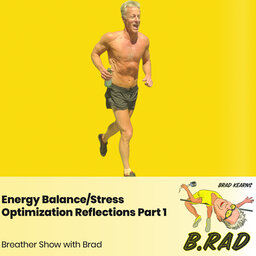Fitness Strategies For Anti-Aging, Part 2 (Breather Episode with Brad)
The B.rad Podcast
Brad Kearns covers health, fitness, peak performance, personal growth, relationships, happiness, and longevity. Slow down, take a deep breath, take a …“Try something that’s a little difficult, a little out of your comfort zone, and you’ll get better and better each day.”
Even incredible feats like 10K runs and half marathons do not have a high demand for advanced balance skills, so throwing in some basic workouts and integrating them into your fitness routine in order to hone your balancing skills is a key fitness strategy for anti-aging, one that will be discussed in detail in this episode. Since these exercises aren’t time-consuming or strenuous, they don’t interfere with the energy expenditure that you put out towards other goals/endeavors, and while they are challenging, they’re also super fun to do, especially because they give you the opportunity to strive towards getting better at something. For example, if you’re one of those people who often hoists a heavy bar and is putting a lot of weight on your back, why don’t you try putting one leg on an elevated surface (the Bulgarian split squat) and squatting down on a single leg without even adding any weight at all? Just simply performing that move for let’s say, 12 reps….you might even be sore the next day! I’ve experienced this myself—performing a nice set of squats with heavy weight, but then after switching over to one leg squats, well, all bets are off! But building new skills is important—especially your ability to do exercises one leg at a time, because most athletic/fitness and everyday activities are performed one leg at a time (walking, running, jumping).
In contrast, a lot of stuff we do in daily life (athletic, fitness, even work related) is done with two arms at a time—we lift things with two hands, we carry things frequently with two hands, but one leg at a time seems to be the prevailing athletic and fitness endeavor—however we don’t work at one leg at a time too often. If you look through my Morning Routine online course, you’ll see I have included some interesting balancing challenges in there, and it’s kind of fun to reflect on what I’ve noticed from a daily practice of doing exercises—I am getting a tiny bit better, but when I step on that soft 2.5 inch pad and try to balance on one leg for a count of 60, while it’s not stenegous to my muscles, I’ve realized it’s much more of a challenge to the brain. Whenever I step off, I feel a sense of central nervous system fatigue from simply concentrating so hard! So giving your brain a little challenge like this is super helpful, and I would contend, translates directly to all manner of not only fitness endeavors, but cognitive endeavors too. There is a huge need for an emphasis on balance training in fitness—just see this Dr. Luks article about the importance of balance training and why, for the elderly, each fall becomes progressively harder to recover from—as scary as it sounds, sadly 50% of people who fall die within a year of suffering a hip fracture. So minimizing our risk of falling is an integral healthy aging practice, especially as it helps dramatically accelerate both the speed and success of our recovery, if we do end up falling—because we head into an unfortunate situation fully loaded with all the positive, helpful attributes that can help us, instead of going into something with frailty. And interestingly, as I mentioned in the previous show, the senior citizen age group has the highest rate of improvement from strength training than any other age group!
When you have a great commitment to health and fitness in your young years and decades, you will induce epigenetic changes that will affect your lifespan, according to Dr. Luks. So an athletic youth spent building muscle mass, doing explosive efforts and working on balance, will imprint into your genes that you are an athletic person, and you will hold onto these attributes—even if you slip and fall off as you get older. Once it’s time to turn it back on and return to the gym, court, etc, you'll be much more adaptable. And of course, exercise leads to some of these genes being turned on, and some of these genes can decrease your risk for cardiovascular disease, premature aging, neurocognitive decline, and so on. Remember: it is never too late to start, no matter where you’re starting from. Also, it’s never too early to start (something important to emphasize nowadays since today’s youth is less active than ever thanks to modern life and technology, which has eliminated a lot of the built-in activity that used to be a necessary part of modern life).
Check out my YouTube channel for jumping drill videos and other balance training content, and my Morning Routine Online course here.
TIMESTAMPS:
Do something out of your comfort zone. One leg at a time seems to be the prevailing athletic fitness endeavor, but we don’t usually practice that. [00:19]
After falling, the success of your recovery and the speed of your recovery is going to be dramatically accelerated because you went into the misfortune fully loaded with all the attributes rather than going into something with frailty. [03:09]
It’s never too late to get in shape and it’s never too early. Today’s youth are much less active than their predecessors. [07:37]
What exercises are good to improve balance? [09:46]
Flexibility and mobility work will add to your fitness goals. [12:04]
What will happen to me if I don’t stay fit? The presence of visceral fat is indicative of all kinds of other problems under the hood. [15:22]
If you step on the scale to monitor your health, realize you have a natural fluctuation of around four to five pounds. [22:54]
Chronic sitting and chronic consumption of heavily processed foods promotes chronic inflammation. Also, plastics touching our food causes inflammation. [26:03]
Anything you put on your skin goes right into your bloodstream. Read the labels. [28:04]
It is not safe to ride bicycles on the streets dodging vehicles. Wear gaudy clothing if you are on bikes. [32:42]
Air pollution surrounds us. [35:22]
The accumulation of the little spare tire is a reliable sign of adverse lifestyle practices for both males and females. [37:18]
The most important thing to look for in your blood chemistry is the triglyceride to HDL ratio. [40:22]
It is always important to be reminded of the dietary recommendations Brad presents. Remove all industrial seed oils from your cupboard. [43:39]
We don’t need to accept discomfort after eating something. Learn what your body can tolerate and what it cannot. [50:34]
There are many benefits from fasting, but don’t forget that it is a stress response. [56:04]
LINKS:
- Brad Kearns.com
- Brad’s Shopping page
- Brad Kearns’s Morning Routine
- Brad’s First Simpler Morning Routine
- Drinking bird exercise
- 4 essential bodyweight single-leg exercises
- Jumping exercises
- Melanie Avalon podcast on cosmetics
- BeautyCounter.com
- Rear View Mirrors for cyclist
- Podcast with Jay Feldman no. 1
- Podcast with Jay Feldman no. 2
Join Brad for more fun on:
Instagram: @bradkearns1
Facebook: @bradkearnsjumphigh
Twitter: @bradleykearns
YouTube: @BradKearns
TikTok: @bradkearns
-
We appreciate all feedback, and questions for Q&A shows, emailed to podcast@bradventures.com. If you have a moment, please share an episode you like with a quick text message, or leave a review on your podcast app. Thank you!
Check out each of these companies because they are absolutely awesome or they wouldn’t occupy this revered space. Seriously, Brad won’t promote anything he doesn’t absolutely love and use in daily life.
- Brad’s Macadamia Masterpiece: Mind-blowing, life-changing nut butter blend
- Male Optimization Formula with Organs (MOFO): Optimize testosterone naturally with 100% grassfed animal organ supplement
- BeautyCounter: Complete line of cosmetics tested to be free of typical toxins and endocrine disruptors. Try Brad's favorite vitamin-C skin serum and make the switch away from toxic mainstream skin-care products!
- Butcher Box: Convenient, affordable home delivery - free shipping! - of the highest quality meat, poultry, and seafood with customizable box design. Click here for special promotion.
- Bala Enzyme: Electrolyte and triple enzyme recovery drink mix. BRAD30 for 30% off
- BiOptimizers: Top quality performance supplements like magnesium, probiotics, and digestive enzymes. BRAD10 for 10% off
- Paleo Valley: Nutrient-rich, ancestral inspired health products. BRAD15 for 15% off
- BradNutrition.com: Coming soon - the ultimate whey protein superfuel formula for peak performance and longevity
- Ultimate Morning Routine Online Course: Learn how to custom-design an energizing, focusing morning exercise routine. Enroll now for earlybird discount
Check out Brad Kearns Favorites Page for great products and discounts
 The B.rad Podcast
The B.rad Podcast


